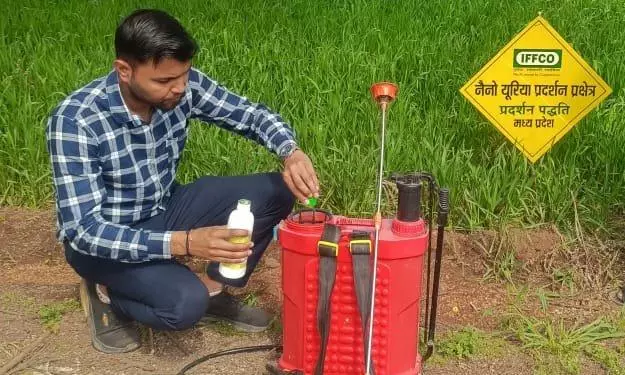
Interim Budget: Nano urea can cut subsidy bills, but what about yield?
Govt is trying to slash subsidy bill by pushing nano urea, a non-subsidised fertiliser, but farmers are resisting it because it cuts yield and protein by 15-20%

In her Interim Budgetspeech, Finance Minister Nirmala Sitharaman said nano DAP (diammonium phosphate) would be promoted for use on a variety of crops and in all agro-climatic zones after the “successful adoption” of nano urea. Nano urea is being produced by IFFCO, a large cooperative.
Urea is sold as prills (pellets) and is applied to the soil. It is highly subsidised.
The international price per tonne in November, excluding insurance and freight charges, was ₹32,000 or ₹1,600 per bag of 50 kg. The retail price is fixed at ₹268 per bag of 50 kg (though, to reduce usage, urea is sold in 45-kg bags as farmers tend to use a bag and not kg as a measure).
The retail prices of fertilisers like DAP and mureate of potash are not controlled but they get a smaller subsidy. So farmers use less than the recommended dose of these fertilisers and overapply urea. This has driven up the subsidy bill and impacted soil health.
Fertiliser economics
Urea is 46 per cent nitrogen and nano urea 4 per cent. Two bags of urea are required to be applied on one acre of rice or wheat. A scientist this writer spoke to in Punjab Agricultural University (PAU), who did not wish to be named, said as per the cooperative, 1 litre of nano urea can displace one bag of urea.
Nano urea is to be sprayed on leaves in two instalments, once at the tillering or branching stage and another before flowering. That is, 40 grams of nitrogen delivered via a litre of nano urea can replace a 50 kg bag of urea containing 23 kg of nitrogen.
Plants do not absorb all the nitrogen in urea applied to soil. About 60 per cent evaporates or leaches into the soil. So, a 50 kg bag of urea makes around 9 kg of nitrogen available to crops.
Challenge with nano urea
PAU did a study on nano urea in its campus farms and in farmers’ fields at 17 of its Krishi Vigyan Kendras (KVKs). The PAU scientist said they observed a yield reduction of 15-20 per cent and protein reduction of a like amount.
A scientist at the Indian Agricultural Research Institute (IARI), which did trials of nano urea for IFFCO, said there was no yield reduction in rice when 75 per cent of the recommended dose of urea was applied to soil along with one litre of nano urea per acre.
But, when urea was reduced to 50 per cent, as recommended by IFFCO, and a litre of nano urea was sprayed, there was a “significant decline” in rice yield. The scientist also did not want to be named for fear of adverse consequences.
Bio-safety study
The IARI scientist said 1 hectare (2.5 acres) of rice produces on average 6 tonnes of grain and 6 tonnes of straw. The grain and straw have 120 kg of nitrogen.
If urea in the form of prills and foliar spray doesn’t supply this quantity of the nutrient, plants will draw the shortfall from nitrogen reserves in soil. Over time, soil nitrogen will get depleted and it will tell on yields.
Both the scientists said the bio-safety of nitrogen delivered as nano particles should be studied. There were no such studies, they said
IFFCO’s claims
IFFCO says on its website that nano urea has been tested for efficacy, safety, toxicity, and environmental suitability in credible laboratories. It says nitrogen in nano particles is absorbed through cell walls and through leaf stomata walls. It asserts that the product has undergone trials in over 11,000 farmer fields on 94 crops.
Also, 20 agricultural research institutes and universities have tried it on 43 crops. It has detailed tables of yield increases observed in various states. An IARI study found that 25-50 per cent reduction in nitrogen fertiliser use in wheat and mustard was possible with two sprays of nano nitrogen, it claims.
Nano urea retails for ₹225 per half litre. If farmers save one bag of 50 kg urea (₹268), with two bottles of nano urea (₹450), they would be net losers. Spraying is an added cost.
The government is pushing nano urea as it is not subsidised. But farmers are resisting. In Haryana, they have been protesting against fertiliser dealers thrusting nano urea on them when selling urea.
Nano urea, a wonder product?
Nano urea is seen as a wonder product in official circles. While inaugurating the IFFCO nano urea plant in Gujarat last May, Prime Minister Narendra Modi exulted in the power of a bag of urea being available in a 500 ml bottle.
In October, Home Minister Amit Shah inaugurated the cooperative’s nano DAP plant. Earlier, in October 2021, the Indian Air Force delivered nano urea to Sri Lanka at the request of its government after its decision to go wholly organic backfired and drastically reduced the island nation’s rice output.
The government is understandably eager to pare the fertiliser subsidy bill. The revised estimate for this year is ₹1.89 trillion against the Budget estimate of ₹1.75 trillion. The Budget estimate for next year is ₹1.64 trillion.
If innovative fixes can help, policymakers should try them out without being too risk averse. But magical thinking can result in unintended adverse consequences.

